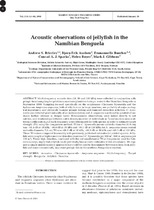| dc.contributor.author | Brierley, Andrew S. | |
| dc.contributor.author | Axelson, Bjorn Erik | |
| dc.contributor.author | Buecher, Emmanuelle | |
| dc.contributor.author | Sparks, Conrad A.J. | |
| dc.contributor.author | Boyer, Helen | |
| dc.contributor.author | Gibbons, Mark J. | |
| dc.date.accessioned | 2011-09-08T07:35:49Z | |
| dc.date.available | 2011-09-08T07:35:49Z | |
| dc.date.issued | 2001 | |
| dc.identifier.citation | Brierley, A.S., et al. (2001). Acoustic observations of jellyfish in the Namibian Benguela. Marine Ecology Progress Series, 210: 55-66 | en_US |
| dc.identifier.issn | 0171-8630 | |
| dc.identifier.uri | http://hdl.handle.net/10566/246 | |
| dc.description.abstract | Multi-frequency acoustic data (18, 38 and 120 kHz) were collected in conjunction with pelagic trawl sampling for gelatinous macrozooplankton during a cruise to the Namibian Benguela in September 1999. Sampling focused specifically on the scyphozoan Chrysaora hysoscella and the hydrozoan Aequorea aequorea, both of which occur in large numbers, are probably of major ecological importance, and physically hamper pelagic fishing and diamond extraction activities. C. hysoscella was detected predominantly at an inshore station and A. aequorea was found in greatest abundance further offshore in deeper water. Echo-sounder observations were linked directly to net catches, and relationships between catch density (number of individuals m–3) and nautical area scattering coefficients (sA) at each frequency were determined for both species in order to estimate target strength (TS) using the comparison method. TS for C. hysoscella (mean umbrella diameter 26.8 cm) was –51.5 dB at 18 kHz, –46.6 dB at 38 kHz and –50.1 dB at 120 kHz; for A. aequorea (mean central umbrella diameter 7.4 cm) TS was –68.1 dB at 18 kHz, –66.3 dB at 38 kHz and –68.5 dB at 120 kHz. These TS values compared favourably with previously published estimates for related species. Jellyfish were caught at high numerical densities (maxima 3 C. hysoscella per 100 m3, 168 A. aequorea per 100 m3). These high densities, combined with the not unsubstantial TS at frequencies used for fisheries surveys, imply that jellyfish could potentially bias acoustic estimates of fish abundance. We suggest a simple multifrequency approach that could be used to discriminate between echoes from jellyfish and some commercially important pelagic fish in the northern Benguela ecosystem. | en_US |
| dc.language.iso | en | en_US |
| dc.publisher | Inter-Research | en_US |
| dc.relation.ispartofseries | Marine Ecology Progress Series; | |
| dc.rights | Copyright Inter-Research. The 4 year embargo on displaying the full text of this article has expired. | |
| dc.source.uri | http://dx.doi.org/10.3354/meps210055 | |
| dc.subject | Namibia | en_US |
| dc.subject | Jellyfish | en_US |
| dc.subject | Multi-frequency hydroacoustics | en_US |
| dc.subject | Biomass | en_US |
| dc.subject | Target strength | en_US |
| dc.subject | Northern Benguela | en_US |
| dc.title | Acoustic observations of jellyfish in the Namibian Benguela | en_US |
| dc.type | Article | en_US |
| dc.inquiries | mgibbons@uwc.ac.za | |
| dc.privacy.showsubmitter | true | |
| dc.status.ispeerreviewed | true | |

